Leadership Styles and Employee Motivation
VerifiedAdded on 2020/05/28
|9
|2375
|225
AI Summary
This assignment examines a workplace scenario featuring Tom, an employee struggling under Frank's authoritarian leadership. The analysis explores the detrimental effects of this leadership style on employee motivation and suggests alternative, more effective approaches to enhance performance and reduce turnover.
Contribute Materials
Your contribution can guide someone’s learning journey. Share your
documents today.

Running head: LEADERSHIP AND MANAGEMENT
Challenge the Boss or Stand Down?
Name of the Student:
Name of the University:
Author Note:
Challenge the Boss or Stand Down?
Name of the Student:
Name of the University:
Author Note:
Secure Best Marks with AI Grader
Need help grading? Try our AI Grader for instant feedback on your assignments.

1
LEADERSHIP AND MANAGEMENT
Introduction
Leadership is the integral part of an organisation that leads the employees
towards acquiring the goals. The case study is also focusing on developing the
understanding regarding the leadership and performance management. The study
reflects the ineffective interpersonal relationship with Tom with Frank that was visible in
their conversation. The study would thus reflect on the specific issues drawn from the
case study and apply the suitable theories to mitigate the challenges accordingly. The
identification of the underlying issues and applied theories are described below:
Ans.1) Identification of the Issues
The case study highlights some of the specific issues that have the considerable
impacts on the organisational performance. These identified issues are discussed
further.
1. Lack of Motivation
The case scenario clearly portrays the motivational issues portrayed through the
behaviour of Tom. The ineffective leadership style of Tom had failed to address the
suitable work atmosphere for the employees that affected the profitability parameter of
the company.
2. Lack of Employee Empowerment
The scenario in the discussion board clearly highlights that the employees are not
allowed to take participations in a decision making process. They do not receive the
opportunity to present their concerns as Frank was too strict to be interrupted by others.
The lack of employee empowerment affects the morale in a considerable way.
3. Leadership ineffectiveness
The ineffective leadership is quite recognizable in this case scenario. It is noticed
that Frank was quite authoritative in nature and was reluctant to concentrate on Tom’s
LEADERSHIP AND MANAGEMENT
Introduction
Leadership is the integral part of an organisation that leads the employees
towards acquiring the goals. The case study is also focusing on developing the
understanding regarding the leadership and performance management. The study
reflects the ineffective interpersonal relationship with Tom with Frank that was visible in
their conversation. The study would thus reflect on the specific issues drawn from the
case study and apply the suitable theories to mitigate the challenges accordingly. The
identification of the underlying issues and applied theories are described below:
Ans.1) Identification of the Issues
The case study highlights some of the specific issues that have the considerable
impacts on the organisational performance. These identified issues are discussed
further.
1. Lack of Motivation
The case scenario clearly portrays the motivational issues portrayed through the
behaviour of Tom. The ineffective leadership style of Tom had failed to address the
suitable work atmosphere for the employees that affected the profitability parameter of
the company.
2. Lack of Employee Empowerment
The scenario in the discussion board clearly highlights that the employees are not
allowed to take participations in a decision making process. They do not receive the
opportunity to present their concerns as Frank was too strict to be interrupted by others.
The lack of employee empowerment affects the morale in a considerable way.
3. Leadership ineffectiveness
The ineffective leadership is quite recognizable in this case scenario. It is noticed
that Frank was quite authoritative in nature and was reluctant to concentrate on Tom’s
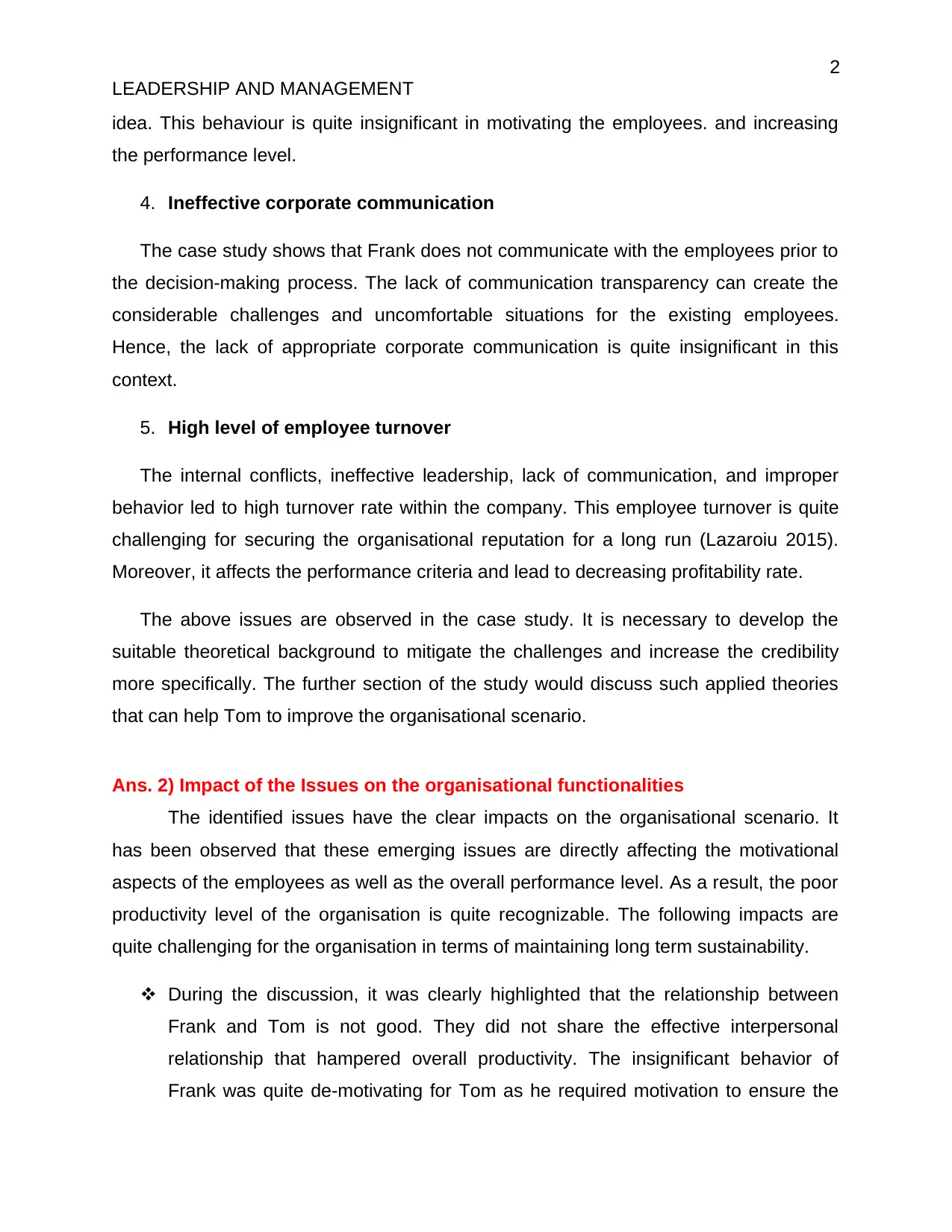
2
LEADERSHIP AND MANAGEMENT
idea. This behaviour is quite insignificant in motivating the employees. and increasing
the performance level.
4. Ineffective corporate communication
The case study shows that Frank does not communicate with the employees prior to
the decision-making process. The lack of communication transparency can create the
considerable challenges and uncomfortable situations for the existing employees.
Hence, the lack of appropriate corporate communication is quite insignificant in this
context.
5. High level of employee turnover
The internal conflicts, ineffective leadership, lack of communication, and improper
behavior led to high turnover rate within the company. This employee turnover is quite
challenging for securing the organisational reputation for a long run (Lazaroiu 2015).
Moreover, it affects the performance criteria and lead to decreasing profitability rate.
The above issues are observed in the case study. It is necessary to develop the
suitable theoretical background to mitigate the challenges and increase the credibility
more specifically. The further section of the study would discuss such applied theories
that can help Tom to improve the organisational scenario.
Ans. 2) Impact of the Issues on the organisational functionalities
The identified issues have the clear impacts on the organisational scenario. It
has been observed that these emerging issues are directly affecting the motivational
aspects of the employees as well as the overall performance level. As a result, the poor
productivity level of the organisation is quite recognizable. The following impacts are
quite challenging for the organisation in terms of maintaining long term sustainability.
During the discussion, it was clearly highlighted that the relationship between
Frank and Tom is not good. They did not share the effective interpersonal
relationship that hampered overall productivity. The insignificant behavior of
Frank was quite de-motivating for Tom as he required motivation to ensure the
LEADERSHIP AND MANAGEMENT
idea. This behaviour is quite insignificant in motivating the employees. and increasing
the performance level.
4. Ineffective corporate communication
The case study shows that Frank does not communicate with the employees prior to
the decision-making process. The lack of communication transparency can create the
considerable challenges and uncomfortable situations for the existing employees.
Hence, the lack of appropriate corporate communication is quite insignificant in this
context.
5. High level of employee turnover
The internal conflicts, ineffective leadership, lack of communication, and improper
behavior led to high turnover rate within the company. This employee turnover is quite
challenging for securing the organisational reputation for a long run (Lazaroiu 2015).
Moreover, it affects the performance criteria and lead to decreasing profitability rate.
The above issues are observed in the case study. It is necessary to develop the
suitable theoretical background to mitigate the challenges and increase the credibility
more specifically. The further section of the study would discuss such applied theories
that can help Tom to improve the organisational scenario.
Ans. 2) Impact of the Issues on the organisational functionalities
The identified issues have the clear impacts on the organisational scenario. It
has been observed that these emerging issues are directly affecting the motivational
aspects of the employees as well as the overall performance level. As a result, the poor
productivity level of the organisation is quite recognizable. The following impacts are
quite challenging for the organisation in terms of maintaining long term sustainability.
During the discussion, it was clearly highlighted that the relationship between
Frank and Tom is not good. They did not share the effective interpersonal
relationship that hampered overall productivity. The insignificant behavior of
Frank was quite de-motivating for Tom as he required motivation to ensure the
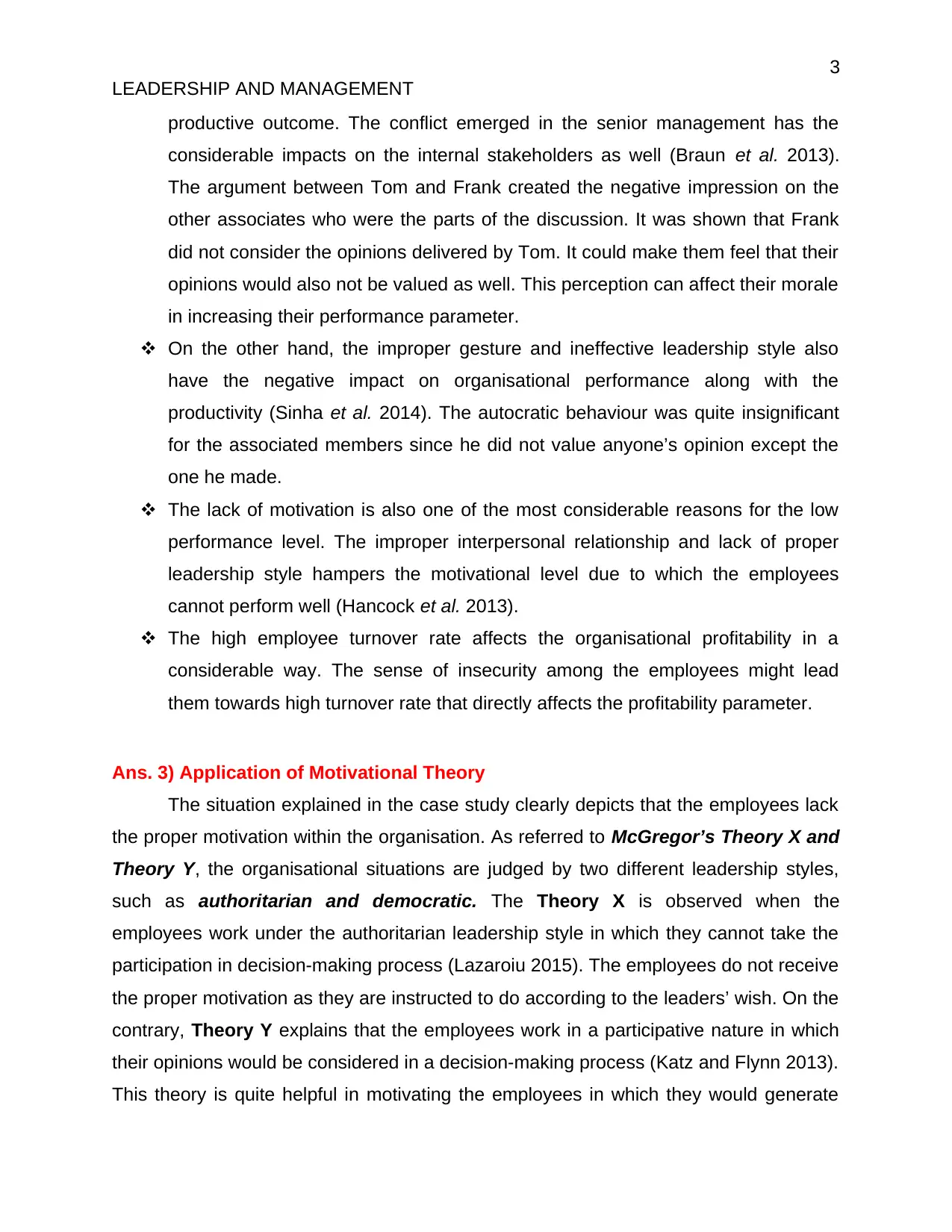
3
LEADERSHIP AND MANAGEMENT
productive outcome. The conflict emerged in the senior management has the
considerable impacts on the internal stakeholders as well (Braun et al. 2013).
The argument between Tom and Frank created the negative impression on the
other associates who were the parts of the discussion. It was shown that Frank
did not consider the opinions delivered by Tom. It could make them feel that their
opinions would also not be valued as well. This perception can affect their morale
in increasing their performance parameter.
On the other hand, the improper gesture and ineffective leadership style also
have the negative impact on organisational performance along with the
productivity (Sinha et al. 2014). The autocratic behaviour was quite insignificant
for the associated members since he did not value anyone’s opinion except the
one he made.
The lack of motivation is also one of the most considerable reasons for the low
performance level. The improper interpersonal relationship and lack of proper
leadership style hampers the motivational level due to which the employees
cannot perform well (Hancock et al. 2013).
The high employee turnover rate affects the organisational profitability in a
considerable way. The sense of insecurity among the employees might lead
them towards high turnover rate that directly affects the profitability parameter.
Ans. 3) Application of Motivational Theory
The situation explained in the case study clearly depicts that the employees lack
the proper motivation within the organisation. As referred to McGregor’s Theory X and
Theory Y, the organisational situations are judged by two different leadership styles,
such as authoritarian and democratic. The Theory X is observed when the
employees work under the authoritarian leadership style in which they cannot take the
participation in decision-making process (Lazaroiu 2015). The employees do not receive
the proper motivation as they are instructed to do according to the leaders’ wish. On the
contrary, Theory Y explains that the employees work in a participative nature in which
their opinions would be considered in a decision-making process (Katz and Flynn 2013).
This theory is quite helpful in motivating the employees in which they would generate
LEADERSHIP AND MANAGEMENT
productive outcome. The conflict emerged in the senior management has the
considerable impacts on the internal stakeholders as well (Braun et al. 2013).
The argument between Tom and Frank created the negative impression on the
other associates who were the parts of the discussion. It was shown that Frank
did not consider the opinions delivered by Tom. It could make them feel that their
opinions would also not be valued as well. This perception can affect their morale
in increasing their performance parameter.
On the other hand, the improper gesture and ineffective leadership style also
have the negative impact on organisational performance along with the
productivity (Sinha et al. 2014). The autocratic behaviour was quite insignificant
for the associated members since he did not value anyone’s opinion except the
one he made.
The lack of motivation is also one of the most considerable reasons for the low
performance level. The improper interpersonal relationship and lack of proper
leadership style hampers the motivational level due to which the employees
cannot perform well (Hancock et al. 2013).
The high employee turnover rate affects the organisational profitability in a
considerable way. The sense of insecurity among the employees might lead
them towards high turnover rate that directly affects the profitability parameter.
Ans. 3) Application of Motivational Theory
The situation explained in the case study clearly depicts that the employees lack
the proper motivation within the organisation. As referred to McGregor’s Theory X and
Theory Y, the organisational situations are judged by two different leadership styles,
such as authoritarian and democratic. The Theory X is observed when the
employees work under the authoritarian leadership style in which they cannot take the
participation in decision-making process (Lazaroiu 2015). The employees do not receive
the proper motivation as they are instructed to do according to the leaders’ wish. On the
contrary, Theory Y explains that the employees work in a participative nature in which
their opinions would be considered in a decision-making process (Katz and Flynn 2013).
This theory is quite helpful in motivating the employees in which they would generate
Secure Best Marks with AI Grader
Need help grading? Try our AI Grader for instant feedback on your assignments.

4
LEADERSHIP AND MANAGEMENT
the feelings of their fruitful existence within a company. Frank requires concentrating on
such aspects and consult with the employees prior to make any organisational
decisions.
Similarly, Maslow’s Law of Needs is another motivation theory that comprises
five-tier model based on human needs. As per the theoretical context, it is essential for
the business leaders to fulfill the basic needs of the employees to keep them committed
and engaged towards the organisational functions (Sinha et al. 2014). The highly
motivated organisational scenario, effective behaviour, and appropriate communication
are some of these basic needs that the employees seek from their business leaders.
Frank lacks such traits that affect the motivational aspects of the existing employees
including Tom. It was essential for Frank to observe the capability of Tom instead of
underestimating his opinions for a better management functions. It was quite de-
motivating for an emerging leader.
Another most appropriate motivational theory is Herzberg’s Two-Factor Theory,
which depicts the two main factors for motivating the employees. The first factor is
hygiene factor that include basic needs, such as salary, insurance, leaves, and so on.
Another factor is motivational factors that include rewards and recognition, growth and
promotional opportunities, responsibility, and meaningfulness of the work (Jungert et al.
2017). Tom is an aspiring leader who tries to grab opportunities for the betterment of the
organisation and associated employees. However, the statements and ineffective
behaviour received from Frank was quite a threat to his job security. Therefore, it
affected his motivational state of mind that could reflect on his performance level. It is
thus essential for Frank to understand the consequence and adopt the better leadership
approach.
The above motivational theories can bring improvement in the organisational
scenario and ensure better outcome for the secured future of the organisation. Frank
needs to realize the importance of motivational aspects to develop high performance
parameter.
LEADERSHIP AND MANAGEMENT
the feelings of their fruitful existence within a company. Frank requires concentrating on
such aspects and consult with the employees prior to make any organisational
decisions.
Similarly, Maslow’s Law of Needs is another motivation theory that comprises
five-tier model based on human needs. As per the theoretical context, it is essential for
the business leaders to fulfill the basic needs of the employees to keep them committed
and engaged towards the organisational functions (Sinha et al. 2014). The highly
motivated organisational scenario, effective behaviour, and appropriate communication
are some of these basic needs that the employees seek from their business leaders.
Frank lacks such traits that affect the motivational aspects of the existing employees
including Tom. It was essential for Frank to observe the capability of Tom instead of
underestimating his opinions for a better management functions. It was quite de-
motivating for an emerging leader.
Another most appropriate motivational theory is Herzberg’s Two-Factor Theory,
which depicts the two main factors for motivating the employees. The first factor is
hygiene factor that include basic needs, such as salary, insurance, leaves, and so on.
Another factor is motivational factors that include rewards and recognition, growth and
promotional opportunities, responsibility, and meaningfulness of the work (Jungert et al.
2017). Tom is an aspiring leader who tries to grab opportunities for the betterment of the
organisation and associated employees. However, the statements and ineffective
behaviour received from Frank was quite a threat to his job security. Therefore, it
affected his motivational state of mind that could reflect on his performance level. It is
thus essential for Frank to understand the consequence and adopt the better leadership
approach.
The above motivational theories can bring improvement in the organisational
scenario and ensure better outcome for the secured future of the organisation. Frank
needs to realize the importance of motivational aspects to develop high performance
parameter.
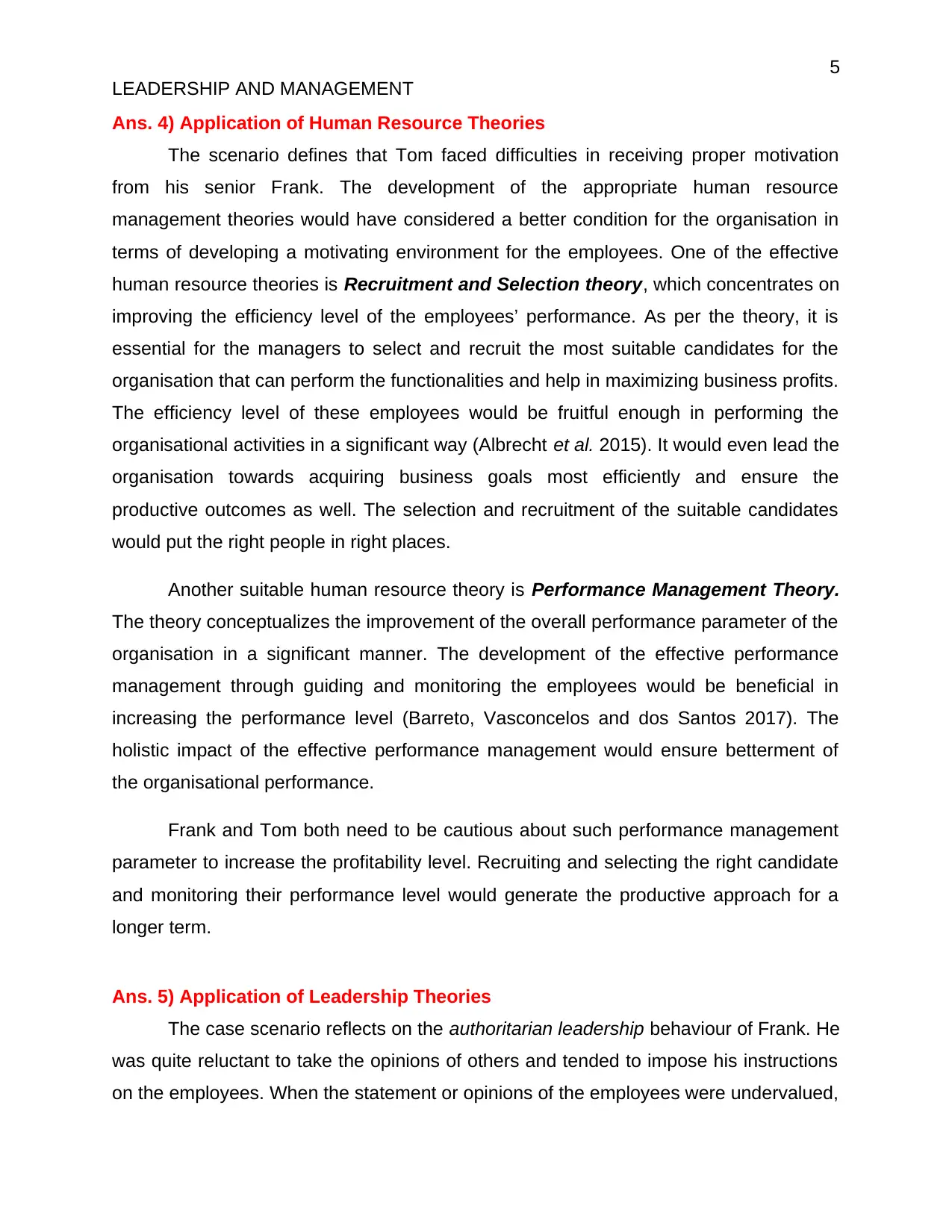
5
LEADERSHIP AND MANAGEMENT
Ans. 4) Application of Human Resource Theories
The scenario defines that Tom faced difficulties in receiving proper motivation
from his senior Frank. The development of the appropriate human resource
management theories would have considered a better condition for the organisation in
terms of developing a motivating environment for the employees. One of the effective
human resource theories is Recruitment and Selection theory, which concentrates on
improving the efficiency level of the employees’ performance. As per the theory, it is
essential for the managers to select and recruit the most suitable candidates for the
organisation that can perform the functionalities and help in maximizing business profits.
The efficiency level of these employees would be fruitful enough in performing the
organisational activities in a significant way (Albrecht et al. 2015). It would even lead the
organisation towards acquiring business goals most efficiently and ensure the
productive outcomes as well. The selection and recruitment of the suitable candidates
would put the right people in right places.
Another suitable human resource theory is Performance Management Theory.
The theory conceptualizes the improvement of the overall performance parameter of the
organisation in a significant manner. The development of the effective performance
management through guiding and monitoring the employees would be beneficial in
increasing the performance level (Barreto, Vasconcelos and dos Santos 2017). The
holistic impact of the effective performance management would ensure betterment of
the organisational performance.
Frank and Tom both need to be cautious about such performance management
parameter to increase the profitability level. Recruiting and selecting the right candidate
and monitoring their performance level would generate the productive approach for a
longer term.
Ans. 5) Application of Leadership Theories
The case scenario reflects on the authoritarian leadership behaviour of Frank. He
was quite reluctant to take the opinions of others and tended to impose his instructions
on the employees. When the statement or opinions of the employees were undervalued,
LEADERSHIP AND MANAGEMENT
Ans. 4) Application of Human Resource Theories
The scenario defines that Tom faced difficulties in receiving proper motivation
from his senior Frank. The development of the appropriate human resource
management theories would have considered a better condition for the organisation in
terms of developing a motivating environment for the employees. One of the effective
human resource theories is Recruitment and Selection theory, which concentrates on
improving the efficiency level of the employees’ performance. As per the theory, it is
essential for the managers to select and recruit the most suitable candidates for the
organisation that can perform the functionalities and help in maximizing business profits.
The efficiency level of these employees would be fruitful enough in performing the
organisational activities in a significant way (Albrecht et al. 2015). It would even lead the
organisation towards acquiring business goals most efficiently and ensure the
productive outcomes as well. The selection and recruitment of the suitable candidates
would put the right people in right places.
Another suitable human resource theory is Performance Management Theory.
The theory conceptualizes the improvement of the overall performance parameter of the
organisation in a significant manner. The development of the effective performance
management through guiding and monitoring the employees would be beneficial in
increasing the performance level (Barreto, Vasconcelos and dos Santos 2017). The
holistic impact of the effective performance management would ensure betterment of
the organisational performance.
Frank and Tom both need to be cautious about such performance management
parameter to increase the profitability level. Recruiting and selecting the right candidate
and monitoring their performance level would generate the productive approach for a
longer term.
Ans. 5) Application of Leadership Theories
The case scenario reflects on the authoritarian leadership behaviour of Frank. He
was quite reluctant to take the opinions of others and tended to impose his instructions
on the employees. When the statement or opinions of the employees were undervalued,
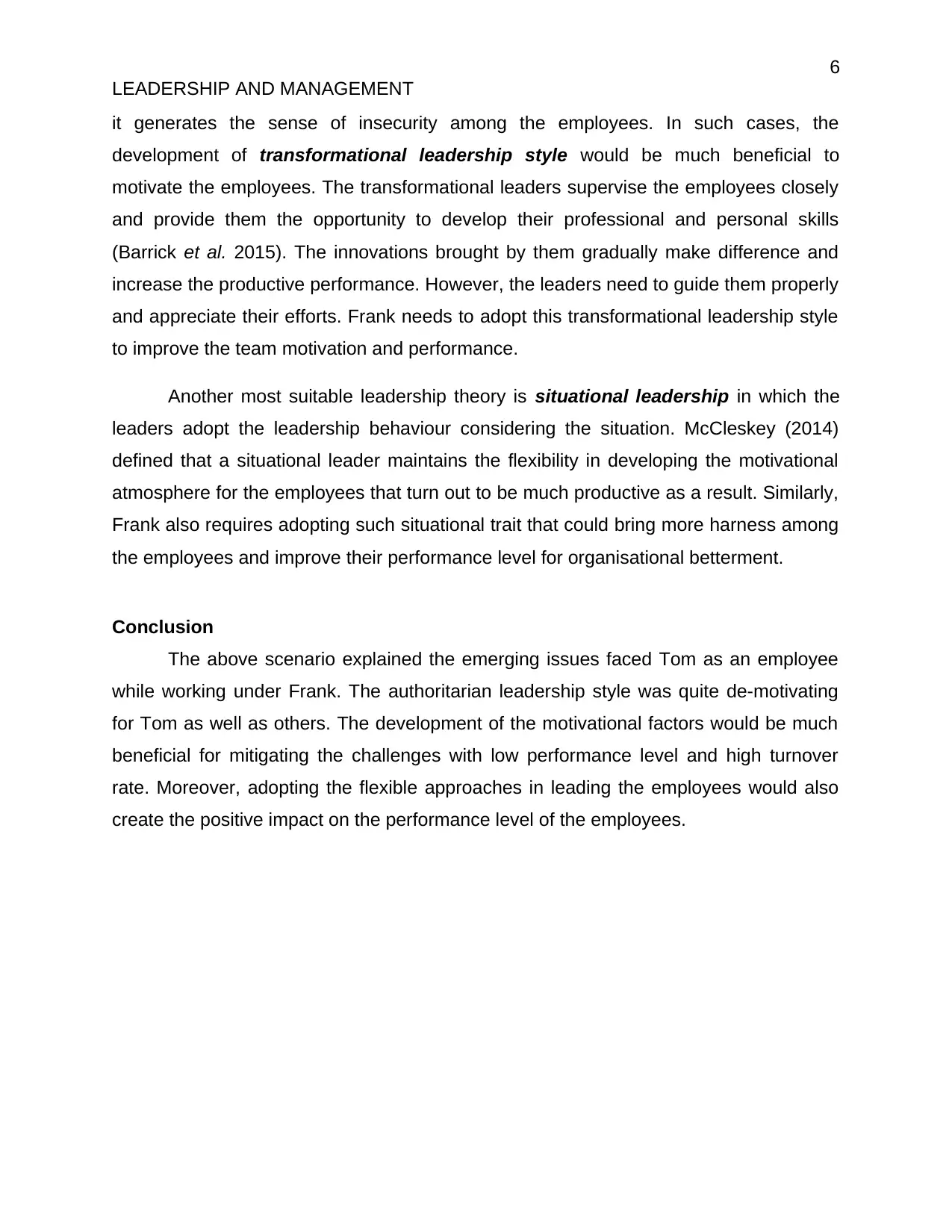
6
LEADERSHIP AND MANAGEMENT
it generates the sense of insecurity among the employees. In such cases, the
development of transformational leadership style would be much beneficial to
motivate the employees. The transformational leaders supervise the employees closely
and provide them the opportunity to develop their professional and personal skills
(Barrick et al. 2015). The innovations brought by them gradually make difference and
increase the productive performance. However, the leaders need to guide them properly
and appreciate their efforts. Frank needs to adopt this transformational leadership style
to improve the team motivation and performance.
Another most suitable leadership theory is situational leadership in which the
leaders adopt the leadership behaviour considering the situation. McCleskey (2014)
defined that a situational leader maintains the flexibility in developing the motivational
atmosphere for the employees that turn out to be much productive as a result. Similarly,
Frank also requires adopting such situational trait that could bring more harness among
the employees and improve their performance level for organisational betterment.
Conclusion
The above scenario explained the emerging issues faced Tom as an employee
while working under Frank. The authoritarian leadership style was quite de-motivating
for Tom as well as others. The development of the motivational factors would be much
beneficial for mitigating the challenges with low performance level and high turnover
rate. Moreover, adopting the flexible approaches in leading the employees would also
create the positive impact on the performance level of the employees.
LEADERSHIP AND MANAGEMENT
it generates the sense of insecurity among the employees. In such cases, the
development of transformational leadership style would be much beneficial to
motivate the employees. The transformational leaders supervise the employees closely
and provide them the opportunity to develop their professional and personal skills
(Barrick et al. 2015). The innovations brought by them gradually make difference and
increase the productive performance. However, the leaders need to guide them properly
and appreciate their efforts. Frank needs to adopt this transformational leadership style
to improve the team motivation and performance.
Another most suitable leadership theory is situational leadership in which the
leaders adopt the leadership behaviour considering the situation. McCleskey (2014)
defined that a situational leader maintains the flexibility in developing the motivational
atmosphere for the employees that turn out to be much productive as a result. Similarly,
Frank also requires adopting such situational trait that could bring more harness among
the employees and improve their performance level for organisational betterment.
Conclusion
The above scenario explained the emerging issues faced Tom as an employee
while working under Frank. The authoritarian leadership style was quite de-motivating
for Tom as well as others. The development of the motivational factors would be much
beneficial for mitigating the challenges with low performance level and high turnover
rate. Moreover, adopting the flexible approaches in leading the employees would also
create the positive impact on the performance level of the employees.
Paraphrase This Document
Need a fresh take? Get an instant paraphrase of this document with our AI Paraphraser

7
LEADERSHIP AND MANAGEMENT
References
Albrecht, S.L., Bakker, A.B., Gruman, J.A., Macey, W.H. and Saks, A.M., 2015.
Employee engagement, human resource management practices and competitive
advantage: An integrated approach. Journal of Organizational Effectiveness: People
and Performance, 2(1), pp.7-35.
Barreto, M.A.M., Vasconcelos, S.S. and dos Santos, E.F., 2017, July. Motivation and
Work: A Survey of the Motivational Aspects in Industries. In International Conference on
Applied Human Factors and Ergonomics (pp. 319-328). Springer, Cham.
Barrick, M.R., Thurgood, G.R., Smith, T.A. and Courtright, S.H., 2015. Collective
organizational engagement: Linking motivational antecedents, strategic implementation,
and firm performance. Academy of Management journal, 58(1), pp.111-135.
Braun, S., Peus, C., Weisweiler, S. and Frey, D., 2013. Transformational leadership, job
satisfaction, and team performance: A multilevel mediation model of trust. The
Leadership Quarterly, 24(1), pp.270-283
Hancock, J.I., Allen, D.G., Bosco, F.A., McDaniel, K.R. and Pierce, C.A., 2013. Meta-
analytic review of employee turnover as a predictor of firm performance. Journal of
Management, 39(3), pp.573-603.
Jungert, T., Van den Broeck, A., Schreurs, B. and Osterman, U., 2017. How Colleagues
Can Support Each Other's Needs and Motivation: An Intervention on Employee Work
Motivation. Applied Psychology, 67(1), pp.3-29.
Katz, N.H. and Flynn, L.T., 2013. Understanding conflict management systems and
strategies in the workplace: A pilot study. Conflict Resolution Quarterly, 30(4), pp.393-
410.
Lazaroiu, G., 2015. Employee motivation and job performance. Linguistic and
Philosophical Investigations, 14, p.97.
LEADERSHIP AND MANAGEMENT
References
Albrecht, S.L., Bakker, A.B., Gruman, J.A., Macey, W.H. and Saks, A.M., 2015.
Employee engagement, human resource management practices and competitive
advantage: An integrated approach. Journal of Organizational Effectiveness: People
and Performance, 2(1), pp.7-35.
Barreto, M.A.M., Vasconcelos, S.S. and dos Santos, E.F., 2017, July. Motivation and
Work: A Survey of the Motivational Aspects in Industries. In International Conference on
Applied Human Factors and Ergonomics (pp. 319-328). Springer, Cham.
Barrick, M.R., Thurgood, G.R., Smith, T.A. and Courtright, S.H., 2015. Collective
organizational engagement: Linking motivational antecedents, strategic implementation,
and firm performance. Academy of Management journal, 58(1), pp.111-135.
Braun, S., Peus, C., Weisweiler, S. and Frey, D., 2013. Transformational leadership, job
satisfaction, and team performance: A multilevel mediation model of trust. The
Leadership Quarterly, 24(1), pp.270-283
Hancock, J.I., Allen, D.G., Bosco, F.A., McDaniel, K.R. and Pierce, C.A., 2013. Meta-
analytic review of employee turnover as a predictor of firm performance. Journal of
Management, 39(3), pp.573-603.
Jungert, T., Van den Broeck, A., Schreurs, B. and Osterman, U., 2017. How Colleagues
Can Support Each Other's Needs and Motivation: An Intervention on Employee Work
Motivation. Applied Psychology, 67(1), pp.3-29.
Katz, N.H. and Flynn, L.T., 2013. Understanding conflict management systems and
strategies in the workplace: A pilot study. Conflict Resolution Quarterly, 30(4), pp.393-
410.
Lazaroiu, G., 2015. Employee motivation and job performance. Linguistic and
Philosophical Investigations, 14, p.97.
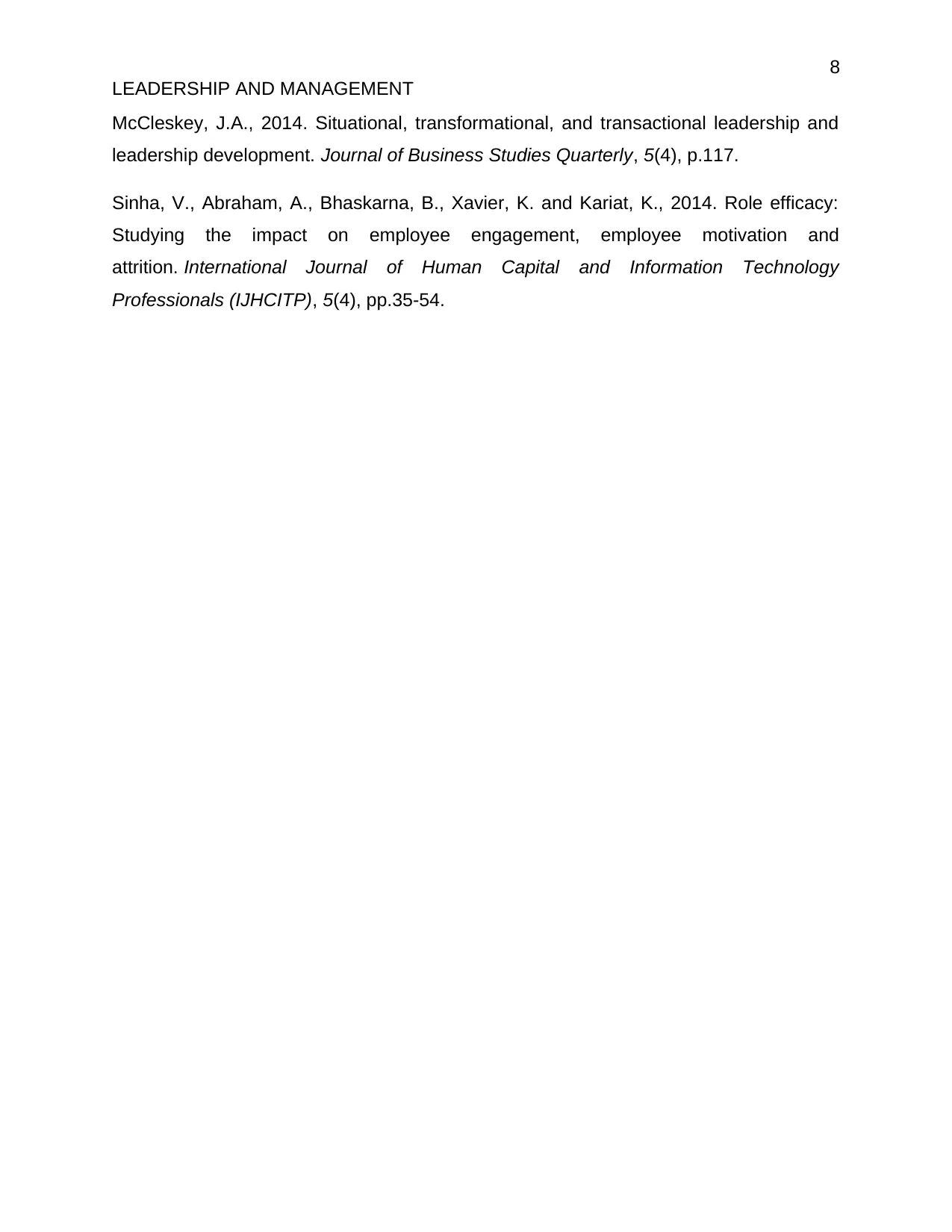
8
LEADERSHIP AND MANAGEMENT
McCleskey, J.A., 2014. Situational, transformational, and transactional leadership and
leadership development. Journal of Business Studies Quarterly, 5(4), p.117.
Sinha, V., Abraham, A., Bhaskarna, B., Xavier, K. and Kariat, K., 2014. Role efficacy:
Studying the impact on employee engagement, employee motivation and
attrition. International Journal of Human Capital and Information Technology
Professionals (IJHCITP), 5(4), pp.35-54.
LEADERSHIP AND MANAGEMENT
McCleskey, J.A., 2014. Situational, transformational, and transactional leadership and
leadership development. Journal of Business Studies Quarterly, 5(4), p.117.
Sinha, V., Abraham, A., Bhaskarna, B., Xavier, K. and Kariat, K., 2014. Role efficacy:
Studying the impact on employee engagement, employee motivation and
attrition. International Journal of Human Capital and Information Technology
Professionals (IJHCITP), 5(4), pp.35-54.
1 out of 9
Related Documents
Your All-in-One AI-Powered Toolkit for Academic Success.
+13062052269
info@desklib.com
Available 24*7 on WhatsApp / Email
![[object Object]](/_next/static/media/star-bottom.7253800d.svg)
Unlock your academic potential
© 2024 | Zucol Services PVT LTD | All rights reserved.



